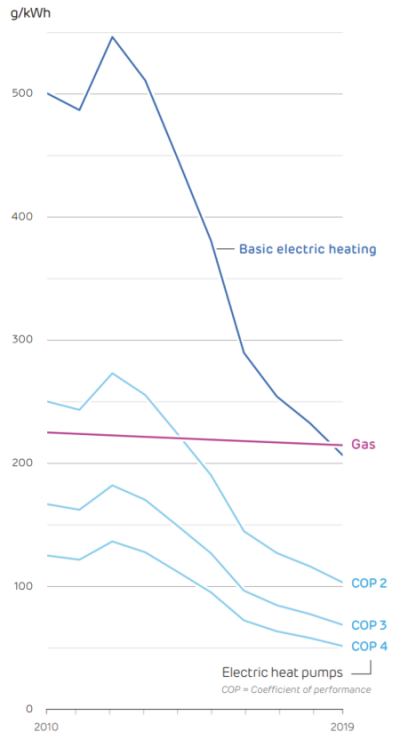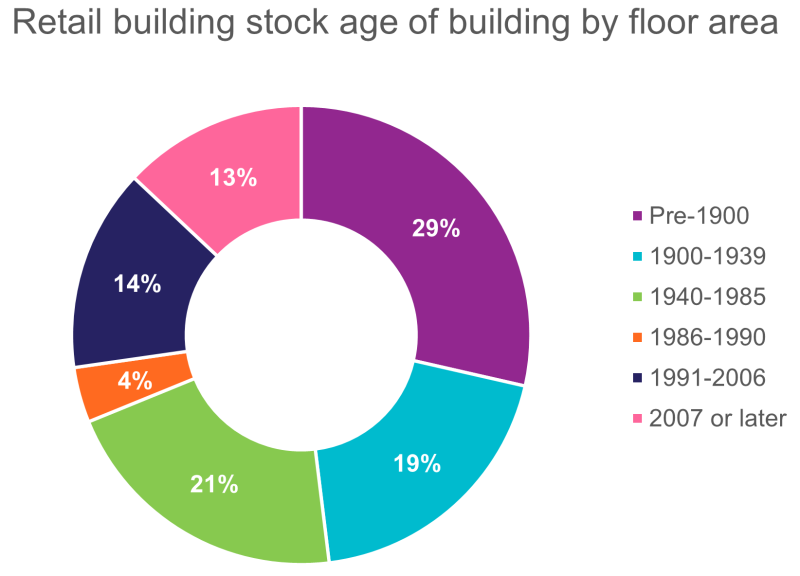5.1.1
Space heating
Emissions profile
Space heating is the largest annual consumer of energy in the retail sector, at 32% of the total energy demand. Emissions from heating sources are approximately evenly split between electric heating and natural gas (46% and 51% of emissions, respectively).
While natural gas is the largest source of emissions, close to 60% of retail floor area in the UK is heated by electrical systems. Emissions from fossil fuels remain high because, in addition to a significant fraction of space heating systems across the non-domestic building stock utilising gas boilers, natural gas is more emissions intensive than electrical heat. Space heating accounts for over 90% of the retail sector’s ‘non-electrical energy consumption’, but only 17% of ‘electrical energy consumption’.[23]
Emissions from heating relate to two key factors:
1. The method of heating (including its efficiency and fuel used).
2. The building fabric (including areas where heat losses occur).
Heating method
The efficiency of heat generation can vary based on a wide range of factors – from the age of heating assets, regularity of system maintenance, configuration of ventilation and more. In general, newer models of heat generating equipment, like condensing boilers, significantly outperform older technologies. However, the adoption rates for these technologies vary – approximately 15% of retail floor area is heated by boilers over 15 years old, for example.[24]
The dominant sources of energy for space heating are electricity and natural gas. The emissions from electric heating systems depend on the makeup of the power grid, with relative emissions intensity relating to the fuel mix and renewables supplying the electricity grid.
As the UK’s power system has become more efficient and more reliant on renewable energy, electric heaters currently produce fewer emissions per unit of heat than gas boilers (see Figure 5.1e).[25] This relatively recent development has significant implications for the adoption of lower carbon heating assets going forward.
However, gas boilers, although currently less efficient, are generally cheaper to operate. The cost advantage of gas heating presents a challenge for decarbonisation – retailers are faced with the choice of electrifying their heating assets at significant expense or sourcing low-carbon gas alternatives, which may be difficult until biogas, renewable biomass, or other alternatives like hydrogen scale up.

Figure 5.1e: grams CO2 per kWh of heating; based on the UK average gas boiler mix
and average generation mix. From Drax Electric Insights Quarterly (2019).
Building fabric
Building fabric refers to the materials and surfaces that separate a building’s interior from its exterior. In retail stores, two-thirds of heat is typically lost through the building fabric (the remainder is lost through air infiltration and ventilation).[26] The main factors influencing heat losses from building fabric are the quality of insulation and the amount of air that can enter the building – through window gaps, joints and fittings, for example. Building fabric has major implications for heating demands – more heat retained means less energy (and cost) expended to maintain desired temperatures.

Figure 5.1f: Proportion of retail building stock by age
New buildings can incorporate energy efficiency measures and construction techniques, like advanced building fabrics, from the outset. However, with construction of new retail and commercial property growing relatively slowly, there remains a significant portion of older building stock – see 5.1f – that is likely to need some degree of refitting in order to minimise heat losses.
Emissions from space heating are reported as scope 1 for direct use of heating fuels (e.g. natural gas) and as scope 2 for heat from electric sources.
Routes to decarbonisation for space heating
The BEES report suggests that retail space heating improvements have the potential to reduce energy consumption by more than 1,000 GWh – about 3.7% of retail’s total demand.
The optimal route for decarbonising space heating needs to be tailored to the premises, particularly in terms of the building fabric and options for refitting. At a high level, the primary methods are: maximizing heating efficiency, electrifying heating systems, greening the gas grid, and district heating.
Cutting emissions from space heating will require both reducing and managing demand through energy efficiency measures, heat storage and demand side response, as well as by decarbonising the supply – by substituting fossil fuels with low-carbon electricity, fuels and heat sources ('low-carbon heat').
Increasing the efficiency of heating by improving building fabrics, where cost-effective, offers potential for short-term and long-lasting emissions reductions. Where retail premises are older and adjustments to the building fabric are either difficult or prohibitive, focus should be drawn to more feasible minor improvements. Interventions like improved insulation, leak-minimising windows and doors and draught stripping reduce heating demands – and offer cost savings over their lifespans.
Retailers with warehouse facilities may find a switch to electric heating very difficult. The preferred route for those retailers should be to adopt gas radiant heaters, but with a pathway for the adoption of biogas supplies.
[23] Building Energy Efficiency Survey (2014-15). BEIS.
[24] Building Energy Efficiency Survey (2014-15). BEIS.
[25] Building Energy Efficiency Survey (2014-15). BEIS.
[26] Building Energy Efficiency Survey (2014-15). BEIS.